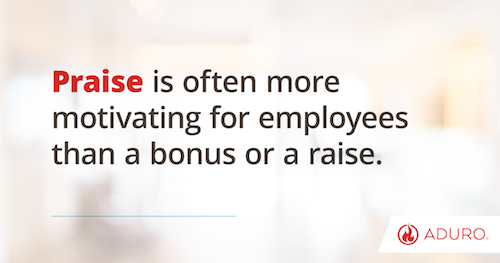Happy employees often lead to happy customers. Why are the two interdependent? Employees are at the front lines of the customer experience, helping people find the right product or delivering them with the best service.
Unfortunately, less than half of U.S. workers (49.6 percent) report being satisfied with their jobs, according to the 2016 edition of The Conference Board Job Satisfaction survey. But Shawn Achor, best-selling author of “The Happiness Advantage,” and other experts say there’s something companies can do to change that. And it’s not just to pay employees more.
Here are three ways to boost employee happiness — and productivity.
Build a Platform for Praise
Research shows that receiving praise is often more motivating than receiving a bonus or a raise, Achor noted in a podcast on the Net Promoter System’s blog. “The momentary pleasure you get from that bonus doesn’t extend for very long,” Achor said in the interview. “But praise is something that is free and organic.” Through his work, he’s discovered that, when an authentic piece of praise is given to each individual on a team, it can result in an exponential increase in productivity.

Managers don’t have to be the sole “praise providers” either. Authentic praise can come from anyone, such as a peer. How can companies help to set the stage for praise? Consider organizing a “Town Hall” meeting each month, where everyone gathers to talk about what’s happening within the company. At the end of the meeting, open the floor for “shout-outs,” where employees can pay compliments to one another. Maybe someone stayed late to help their co-worker meet a deadline. Or someone else took time out of their busy schedule to teach another employee how to use a new program. Praise can lift employees’ spirits, showing them that the work they do each day matters.
Play to People’s Strengths
As the saying goes, if you love what you do, you’ll never have to work a day in your life. That’s why Timothy Butler and James Waldroop, authors of “Understanding ‘People’ People,” rationalized that managers could increase productivity by taking into account employees’ interests and skills during recruitment and project assignments. After analyzing psychological tests of more than 7,000 business professionals, Butler and Waldroop identified four relational dimensions of work that impact job satisfaction, including:
- Influence – People who are strong in this area enjoy being able to influence the outcome of an event through negotiation or persuasion. They also love sharing knowledge and ideas.
- Interpersonal facilitation – Team members in this area are highly skilled at helping others cope with emotional issues and conflict. They often work “behind-the-scenes” and are great mediators.
- Relational creativity – These employees are able to use words and imagery to create emotion, build relationships or motivate others to act. Unlike the “influence” dimension, “relational creativity” doesn’t involve person-to-person interaction. It involves influencing people from a distance.
- Team leadership – Those with strong team leadership skills thrive at working through people to accomplish goals. They’re most concerned with ensuring that the right people and the right processes are in place, in order to accomplish their goals.
By matching your open job positions to these dimensions, you’ll be more likely to recruit the right people — and keep them happy.
Create a Sense of Community
Employees, much like customers, fall on a “me-to-we” continuum when it comes to workplace happiness, according to strategic consultancy Onesixtyfourth’s CultureQ project. They want companies to satisfy their needs first (“me”), and then — at the other end of the spectrum — address the issues that are important to their greater community and world (“we”). Millennials especially want the opportunity to be a part of something bigger than themselves. That’s why companies with organized volunteer programs tend to attract Millennial employees and managers. They have a desire to “do good,” and to belong to organizations that do, too.
How can you create an environment of volunteerism? Consider starting a volunteer program by either partnering with one organization or volunteering with a different one each quarter. You could even survey your employees to find out which causes they care most about, which can help to increase their excitement around and involvement in the program.
For a better approach to employee wellness, download our Flourishing summary: a new way to measure well-being.

